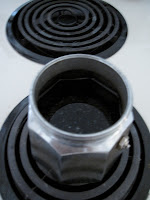Are you wondering why I would write a post about espresso and then not bother to give you any recipe ideas? I mean espresso, on its own, without any "extras" is intense. It can be a small, tasty treat from time to time, but all the time is a bit much.
I would say espresso is best enjoyed after a large meal when your tummy is looking for something to help it settle into the post-consumption phase. More often espresso is appropriate for mixing with other ingredients to create a coffee drink. Here are some of my favorite, easy to make at home recipes.
Cafe con Leche
This simple drink is the reason I purchased a percolator in the first place. Growing up in the US I was used to large (trust me a 20 oz drink is very, very large on a global scale), sweet, mostly milk, coffee drinks. When I moved to Spain for a semester in college, I felt deprived. No where in Madrid served a 20 oz coffee of any sort. The first time I asked for a coffee para llevar, the middle aged man behind the counter laughed at me. They don't take coffee to go in Spain. You stand with your 2 oz beverage at the counter and drink it from a little glass cup.
It took me a while to get used to the idea of standing around drinking coffee, but once I understood the point of it, I was hooked. The point, to Spaniards, is that drinking coffee is an experience. You enjoy the coffee, chat with other patrons, and take a moment to stop and breathe. How nice!
When I returned to the US, I again felt deprived. I couldn't figure out how to get my regular haunts to make a cafe con leche for me. Any combination I could think of would fall short of the real thing. I didn't get it. How hard could it be - 1/2 espresso, 1/2 milk?
The trick, I learned, was that I was over-thinking it. A cafe con leche is a simple drink made from 1 part espresso and 1 part warmed milk. I think the milk is the key. It's not steamed milk, it's warmed milk. They would use an electric burner at the cafes in Spain.
So, I started thinking hard about how to recreate this drink at home. I remembered that every home in Spain had a percolator. Unlike an expensive espresso machine (you have to buy a super pricey one to make anything decent), the percolator could be purchased for $30, is easy to clean, and makes quality espresso. And ta-dah, that leads us to my previous post...Coffee is amazing!
Now the recipe...
Ingredients:
1 freshly brewed batch of stove-top (or electric) espresso
1-2 oz of 2% organic milk
Preparation:
Warm the milk on the stove, or, if your lazy like me, in the microwave for 15 seconds. Pour 1-2 oz of the espresso into the milk. Stir. Smell. Enjoy.
Americano
This is a classic that can be found in any local coffee shop. It is most similar to a regular cup of drip coffee. It is basically a mix of espresso with hot water, and is most often how I enjoy my morning pick-me-up.
Ingredients:
1 freshly brewed batch of stove-top espresso
Hot water
Organic dairy addition of preference
Preparation:
Prepare espresso and boil water in a kettle. When both are ready, mix equal parts espresso and hot water in your favorite mug. Add milk, cream, or leche de agua (this is what my Hispanic friends call skim milk, I think it's an astute label).
The espresso-to-water ratio honestly depends on your preference. More water = weaker coffee. Less water = stronger coffee.
Lattes and Cappuccinos
Ok, so you have, have, have to have foam on your coffee drinks. Fine. You can do that at home too, and again without an expensive espresso machine. Using an electric milk frother, you can get crazy in your own kitchen. These handy little devices are available from $15 - $100. I'd say don't spend more than $30, it would be totally unnecessary. They will whip up some lovely foam in no time at all. I don't personally own one, but I've seen them in action and they work really well.
Ingredients:
1 freshly brewed batch of stove-top espresso
Organic milk of your preference
Preparation:
Brew coffee. Warm milk on the stove or in the microwave until hot. In a glass or metal container froth the milk until foam develops. Using 1 oz of espresso for every 1 shot you would usually order at a cafe, pour the non-foamy milk from the bottom of the container into the espresso first, then top with foam.
The main difference between a latte and a cappuccino is the amount of foam. Lattes are mostly milk with a little bit of foam, cappuccinos are mostly foam with a little bit of milk.
So there ya go! I hope this brings many pleasant coffee experiences your way. And do as the Spaniards do...take time to breathe and enjoy your coffee and your life.











